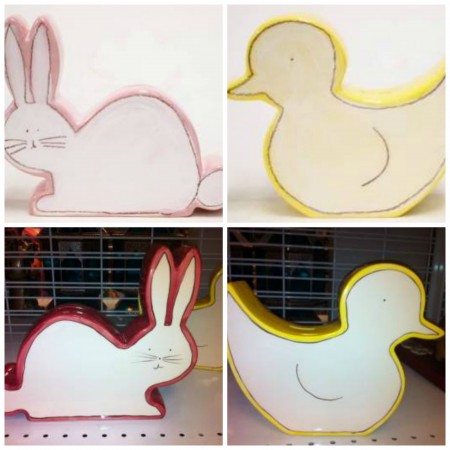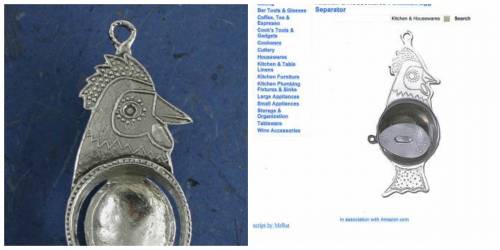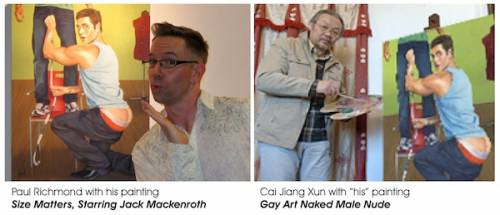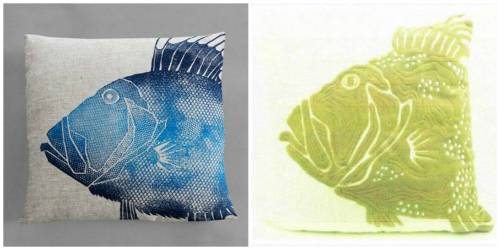Guest blogger Emily Danchuk is an intellectual property attorney and founder of Copyright Collaborative, a web-based subscription program designed to educate, empower and unionize artists across the country in the fight against intellectual property theft.
I think it’s safe to say that the word “infringement” conjures up visions of Chinese factories and dusty marketplaces in India, right? In reality, the practice has become a striking and integral part of many U.S. companies’ business models. Some of the big offenders are making billions (that’s right-billions) of dollars off of the backs of real, skilled artists. Since the problem is not being addressed directly, it doesn’t have any end in sight.
Many artisans who have worked diligently in creating unique works and establishing their goodwill in the industry have been ripped off by “big box” American companies. Another aspect of the “infringement culture” we have right under our noses is internet-based companies, such as Ebay and Etsy, who are able (legally) to turn a blind eye; just take a quick look at Alibaba.com and the problem can’t help but smack you right in the face with its absurdity.

Blatant example of copyright theft. Top, original designs by artist Alex Marshall. Bottom, knock-offs manufactured in China
Some of these “big box” companies have their own retail stores at the ready to accept knock-off lines of products and have the ability to perform quick turn-around production. These companies have been accused of having “design scouts” who attend trade shows to steal the original designs of artists and take them back to their home base for reproduction.
So, while the big box company creates an “instant” product and avoids paying licensing fees to the artist, the original artist is faced with confused retailers who wonder why their sales of the original product are being undercut by a cheaper, infringing version. For example, Williams-Sonoma has been sued for copyright infringement, as has Urban Outfitters.

Chick Egg Separator: Left, original design by Tin Woodsman. Right, Chinese knock-off for sale on Amazon
As for Ebay and Etsy-type companies, their laissez-faire attitudes about knock-offs and outright infringement simply compounds this culture. In 2003, Tiffany, Inc. discovered that over 70% of the “Tiffany” items being sold on Ebay were knock-offs. Tiffany, after urging Ebay to address the problem and failing, sued Ebay in a landmark case. The Court determined that Tiffany, not Ebay, had the burden of policing the Tiffany intellectual property. Ebay claimed that its VeRO infringement reporting program was sufficient to address the problem.
So let’s see how well that VeRO program works – take the Paul Richmond matter, for example. Paul’s friend noticed knock-offs of Paul’s (definitely unique) gay erotic paintings on Ebay. Paul determined that a good number of his paintings were being reproduced in China. Paul used Ebay’s VeRO program to report the infringement, and Ebay removed the post. Only to allow it to be posted again in a week under a different title. Almost two years later, and after many Ebay VeRO reportings, Paul’s paintings are still being sold on Ebay by the same infringer. You can read Paul’s (sometimes hilarious) story on his blog.
Ah, Etsy. I do sometimes wonder if the first ever blog post was written to complain about knock-offs on Etsy. It seems to go that once you post on Etsy, you open up your work to a free-for-all, somewhat like using a Chinese manufacturer. Etsy is chock full of “hobbyists” selling handmade items, many of which are copies of original, career artists, down to the positions of the items in the photograph. I do hope that Etsy will address this problem, as many artists are now refusing to use Etsy to sell their designs because of the prevalence of knock-offs.
Many hard working artists feel helpless when they discover their designs – or similar renditions of their designs – being sold by huge, established companies. They feel that confronting the company will just lead to a war with in-house counsel and that their voices will be ignored and dismissed. Therefore, many artists, believing that the fight isn’t worth the potential battle, simply allow the infringement to occur, and hurry to create new product lines to offset their financial losses and personal feelings of helplessness.
Artists feel violated when their artwork and designs are knocked off. Laura Zindel, the owner of Laura Zindel Design, a small Vermont-based ceramic design company, was recently a victim of infringement by a large, $30 million company.
She explains, “In a very direct way, this knock-off cheapens what we have worked so hard to achieve: quality products made in the USA at a reasonable price. The infringement of our line has undermined the hard work that we put into developing, designing, producing and marketing our line for over fifteen years. For a large company to simply reproduce our line and to say that it was there for the taking is reprehensible. A lot of my time and energy has gone into the backlash of this, and it has monopolized months of my valuable time that should have been spent running my business and creating new works.” The frustration and weariness is often palpable.
As an intellectual property attorney representing artists, I can tell you that the anger and powerlessness is contagious; I oftentimes feel frustrated and just as infuriated as my clients when I’m hired to combat the arrogance of large companies stealing designs and original works of art and making cheap, mass-produced knock-offs.
So, what can artisans and artist-based small companies do? While artists may feel helpless and as if infringement is simply part of the industry, it doesn’t have to be. Artists must understand and remember that these big box companies, and even foreign infringers, want them to feel powerless against the problem and to accept infringement as a cost of doing business.
The more prevalent the practice, the more acceptable it becomes. However, ignorance is not bliss and can be downright costly. Once artists and small companies take a stand by becoming educated on intellectual property right basics, and begin to understand the importance these rights play in their business health and valuation, they gain back some of the power that has been so casually stolen from them. Several actions can be taken by artists, as set forth below:
- Educate Yourself! Understanding the basics of intellectual property rights and the differences between copyrights, trademarks and patents is a responsibility that an artist and business owner must take on. The more you know, the better off your company can be, and the more your business is worth in the long run.
- Register Your Copyrights! Registering your artwork, designs, textual works and any other original works with the United States Copyright Office as soon as they become generally available to the public can mean the difference between a $25,000 immediate settlement and paying a lawyer more than you can afford to stop the infringement months or years down the line. Proper and timely registration of a copyright affords a copyright owner statutory damages of up to $150,000 plus attorneys’ fees and costs, and can be the best weapon to leverage your rights and position in an infringement matter so that you don’t have to slog through costly, stressful and time-consuming litigation.
- Exude Deterrence! Using copyright, trademark and patent notices correctly gives others the impression that you are educated and ready to enforce your intellectual property rights. If you’re in doubt as to how to properly use these notices and symbols, contact a local intellectual property attorney. Include a strong copyright and general intellectual property notice on your website, informing users of the website that your works are registered and you will enforce your rights. Moreover, when you are asked to share your designs with a bigger company who expresses an interest in licensing designs from you, have them acknowledge, in writing, that you are giving them certain proprietary designs only for the purpose of considering and discussing a licensing arrangement. Letting these companies know that you are ready, willing and able to enforce your rights goes a long way in deterring infringement.
- Speak to Other Artists! Once artists start the dialogue and identify the similarities of their infringement stories and experiences, they can begin to work together in a unionized fashion to address the issue of intellectual property theft. As artists identify their problems and struggles with this issue, they can begin to develop solutions and to fight back.
- Strive to be Original! Make a concerted effort to avoid being too “inspired” by other artists and their creative works; remember that imitation isn’t necessarily flattery in the eyes of the original artist. Artists need to stick together to preserve the integrity of their individual and collective works, and this unionization cannot occur until intellectual property theft is viewed as a morally unsound practice.
- Speak Out Against Infringement! While getting a lawyer involved is often necessary, use your voice as well. Calling out infringement and infringing practices is the only way – in this attorney’s opinion – of addressing this problem in any substantive way, instead of chipping away very slowly on a case-by-case basis.






I had a conversation about this topic recently with another artist. We were discussing how copyrighting and trademarking one’s work is more often than not cost prohibitive for the struggling artist. One photographer friend mentioned that at a minimum it was around $50 per image via the Copyright office. She has hundreds of images and no income to support another payment going out. I’m in the same bucket with my images costing many many many hundreds if not thousands of dollars to produce. It seems everyone has their hands in the pocket book of the struggling artist. What’s a viable solution for the many millions of us struggling to make ends meet?
Terri,
One thing I’ve been recently surprised about is that artists don’t know that you can file *collections* under one copyright application with the US Copyright Office. Accordingly, if you have, say, a comprehensive collection of related works (up to about 20 works), and the works were all CREATED in the same YEAR and first PUBLISHED (ie, made publically accessible via a website, trade show, catalog, etc.) on the same DATE, the works can all go under one copyright application as a collection of works. For those financially strapped artists, I would recommend that they copyright their most popular works and biggest sellers (and, of course, anything that has been licensed to a third party). Providing reasonably priced copyright services to artists is one program that Copyright Collaborative is comtemplating (no alliteration intended). I hope this nugget of info helps!
In Canada, copyright is “guaranteed” ,as I understand it when no more than 49 of an item is made. However the enforcement of said copyright domestically isn’t as burdensome as the international “theft” of the visual intellectual property. While the Internet has made possible a sharing of visual statements, it has also been the means by which visual thieves can steal one’s intellectual property just by changing the title of the work a s seen in the example in this article. An artists Union is a great idea, but given the nature of contemporary artists this may be an exercise in futility. As a Union member in an un-related industry ( I have to work another job) solidarity is always an un-ending task, but it could be possible if artists knew their labour history where artisans had guilds that had standards, etcetera that governed and protected their profession. While today’s artistic communities are much more diverse, they nevertheless should be united in solidarity based on intellectual mutual respect. If musicians can form a collective conscience, it seems incumbent on visual artists to do the same to protect their hard sought creativity from corporate and individual visual thievery.
Hi Emily,
Thank you for the response and insight. I think the reason we don’t know this information is that perhaps it’s not easily accessible. Or that we aren’t lawyers with the know how to inquire with the right questions. ; )
I would caution that there is a difference between commodity and art that might be considered “important” art.
Love the alliteration. And yes, this nugget is of real value! Thank you! I will share.
This happens with foods and personal care products too. Look at Trader Joes and Costco. They will usually work with a small farmer or crafter to private label their products just long enough to be sure the product works – then they mass produce it.
A few years ago, I copyrighted my digital portfolio with the US Copyright office for $35.00 total as a compilation. It was a PDF Portfolio file format and had most of my artwork to date then (with the individual copyright dates on each page for each artwork), many commissions I had done up to that time, and the electronic tear sheets from articles, exhibitions, etc. from my paper portfolio (about 160 or so pages).
The only requirement was that it could not contain all of my artwork ever made. I plan on doing it again with work and commissions done since that time frame in a couple of years.
The books I write and now am self-publishing, I always spend the $35 to copyright immediately so that is all protected right away. It is a cost of doing business and much more expensive to do after you have found infringement as there are hefty fees for doing an expedited copyright ($760 or more). Also much more difficult for your lawyer to help you win a case if you haven’t gone through the copyright process.
Great point, Jean. You have prevented a lot of potential heartache with a few simple steps.
One thing that I notice is that artists want to care about copyright, but when faced with a seminar on the copyrights (and I hosted a workshop including this topic last year), they tend to glaze over and not quite get it. It’s a dry subject but I hope that enough people get involved Copyright Collaborative to make a success of this important resource.
The other copyright issue that artists are facing is their own use of someone else’s copyrighted material. Too many people think that if something is on the Internet and not plastered with watermarks, that it is fair game for using in their own artworks.
I have noticed that juried fine art exhibitions are now adding to their prospectus that artwork that contains someone else’s copyrighted material (such as in collage work or digital images), the artwork will not be accepted.
I was very interested to read this as almost all the images from a Musical Series I did several years back are all up on various Chinese websites via Alibaba. These have all been taken from my web site and Fine Art America and are complete with my bio etc. I have contacted Alibaba and the companies only to find them pop up on another site a week or so later. The work was done over several years and I didn’t register copyright on them. Even if I had I actually wonder if it would be worth while chasing up on these sites on Alibaba as there are just so many of them and it could turn into a full time job dealing with it.
While these are all great points, and i thank you for the sharing of it, why then is there a “pin” button that encourages wholesale theft of this??????? You can’t say one thing then do another, or change the rules in the middle of the game. “Pinhercrap” (as i call it) is as abhorrent as any of these rip off companies.
Arlee,
I’m not quite sure I understand your point…the entire premise of the article is to get the information out there, not to protect the words themselves. Copyright Collaborative’s mission is to share information, not hold it back from the masses. I personally have not dealt with any client issues with Pinterest.
Susanne,
Thanks for your comment-I believe it shows the prevalence of the frustration with the larger issue as a whole. Websites such as Alibaba are demonstrative of this larger issue, which seems insurmountable at (many) times. Unfortunately, as with many problems, there is no easy or quick fix. Copyright Collaborative seeks -possibly in an idealist fashion, but in a fashion nonetheless- to provide artists and creatives with potential solutions to the infringement culture that surrounds and suffocates artists. Right now, Copyright Collaborative is starting at the movement level to increase awareness on many levels and to foster innovative ideas to address the problem. My goal-my purpose-is to develop Copyright Collaborative into a comprehensive set of tools to combat the problem that artists face with this issue on a daily basis.
http://www.imdb.com/title/tt1054588/ I recommend as required “reading”, the film Flash of Genius, which tells of how one man invented the intermittent windshield wiper, & how the big automakers stole his idea…
I thought I was on top of things and rarely coming across violations of my work until I did a reverse image search on google and WHAM!!!!!! So far I have found 6 places where people have stolen my images and used them for profit, which has left me very downhearted.
http://jafabrit.blogspot.com/2013/05/image-theft-blingee-and-etsy.html
jafabrit,
Please feel free to call me if you would like to discuss your options! My phone is 917.400.1663.
Best,
Emily
Emily, this is valuable information, thank you so much. And thanks to all for sharing their experiences. Jafabrit, can you please explain how you do a “reverse image search” on Google? I can imagine you would feel very down-hearted and I sympathize.
Thank you,
I am having to deal with problem now…and don’t know how to handle it…..this person is not only recreating my designs..but I just found out ‘re gently that a pair of earrings she bought from me she is selling using her in illegal company name !!!!! I need some help……uughhh
Tess,
Why don’t you give me a call? You can reach me at 917.400.1663.
Emily
As a photographer, I needed exclusive ownership of my work. After some extensive research I found out about this firm called Levy, Levy & Sosa in Miami. I decided to set up a consultation to meet with their attorney and I’m sure glad I did. They assisted me with applying for copyright registration, the process was so simple and they guided me along the way, explaining in ways that were easy to understand.
Why is it actually necessary in the US to register your own work and pay for it to have it protected in case of infringement when there is clearly a law already in place that should take care of this? To me that’s ripping off artists.
Peter,
I tend to agree with you, but mostly due to the fact that the Copyright Office has not informed artists or others that registration helps so much in dealing with infringement. This is a big problem we have.
The reason for registration requirements appears to be to set a verifiable date of creation/publication of the works. One element required to show infringement is that the infringer had access to the works in order to copy them, and therefore the owner has to show that general access to the works was available. In other words, if someone created a work that was exactly like your work, but they had never seen your work, it wouldn’t be copyright infringement, because there was no copying. Therefore, it is best to file a copyright application soon after you’ve published a work so that you can show that your work was copied (i.e., to prove that someone had access to your work to copy it).
I hope this answer helps!
Best,
Emily
Hi Emily,
thank you for your response.
I don’t live in the US and in most other countries according to the Berne Convention (to which, according to my knowledge, the US signed into) a work is automatically copyrighted the moment it exists.
Publication of a work can be proved by the date of the publication. Magazines, Newspapers, Books, tv shows, social media posts, blog’s, webpages, etc. all leave some form of evidence as to the publishing date.
I find it extremely unlikely that some other photographer by coincidence creates the exact same picture at the exact same location at the exact same time showing pixel by pixel the exact same content. I think the same goes for paintings. Such a coincidence would be less likely than finding two people with the exact same DNA.
In the case of design; if I send a copy of my work to myself in a sealed registered letter and never open it – wouldn’t that be proof enough of the date of creation?
Further reading on my behalf suggests that this registration system stems from a time before the Berne Convention and today has become unnecessary and dated, yet protection in the US is only provided if a work is registered. Hence I still believe that this is because there is money to be made and consequently think it’s a ripoff.
What if someone steals an unregistered work from a website or somewhere else and registers it as their own?
Peter
Peter,
You are correct on most of your points…
As for mailing yourself the works, unfortunately this does not work in the United States. Although in the United States, works are protected automatically, like in other countries, you still have to have a registration to bring a lawsuit (or at least a pending application) and to collect statutory damages. It is quite a difficult logic, I agree.
If someone registers your work fraudulently, you can still register the work and contest their registration, most likely with proof of prior creation.
Best,
Emily
Want to know the truth about art theft and the people that do it . Read the blog that I wrote about being at a POD site for two years. Please email me and let me know what you think.
fineartamerica-questioned.blogspot.com
I am a wall decor artist who has been infringed upon repeatedly by those big box stores. They will continue to get away with this until we artists collectively do not support them. The American publishers are pressured to print overseas which worsens the condition. And currently many of the art reps are also feeling the necessity to sell the images directly to china. They often work with the big box supplers to make that big “kill,”. But the artist gets no compensation.
That is appalling, Ruth. I haven’t heard before that artist representatives are going that route. Have you experienced this yourself? Do you know if they are being sued?
Greetings,
I appreciated reading all of the helpful comments. I am a upcoming unknown designer/artist. That has had several pieces of ones art & designs stolen from companies previously mentioned & from other places. It is very sad to see that so many others are experiencing this problem also. Although the theft of my artwork and designs is going so far as they are taking my artwork from my phone, the places where I create the digital art & before I have gotten a chance to release any of my original work to the public. Very very sad.